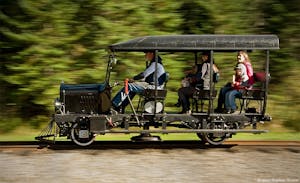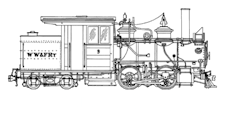Locomotive 9 Rebuild




The Project
Locomotive #9 is the only surviving locomotive from 3 different Maine two foot gauge railroads: the Sandy River & Rangeley Lakes (SR&RL), the Kennebec Central (KC), and the Wiscasset, Waterville & Farmington (WW&F). Additionally, it is the oldest of the surviving Maine Two Footer locomotives (built 1891), and only one of possibly two locomotives surviving from its builder, the Portland Company of Portland, Maine. Therefore it is a unique engine.
A major expense of the restoration was the construction of a new boiler. Ultrasounds on the old boiler indicated excessive disintegration in certain spots. In addition, the boiler was built with a “modified lap-seam” which is now illegal to operate under Maine law. Rather than to destroy the old boiler with numerous patches and fixes, it was decided to preserve the historical integrity of the old boiler, and to set it aside for future generations to view, while building a new boiler for the locomotive to run with and giving it many more years of life. The new boiler was planned to match the old boiler as closely as possible, working within today’s rules and guidelines.
Additionally, the locomotive was assembled with the boiler an integral part of the frame. This technique was used on early standard gauge Forneys, and was used by the Portland Company when it first built the two foot gauge locomotives. Later techniques used by Portland and Baldwin disconnected the boiler from the pulling forces of the train and built a frame around it, much like most locomotives were built. Therefore #9 is being re-assembled with this new frame piece around its firebox.
Work is now nearing completion on the locomotive, and we anticipate the first steam up with the new boiler in the near future. The latest news on number 9’s restoration can be found here.
Project leader is Jason Lamontagne.
Past Milestones
2013:While work progressed on installation of the drivers, a problem was discovered. Number 9’s driving wheels are from two different locomotives, most likely due to damage she suffered in derailments on the Sandy River. As a result, this affected the placement of the crank pins on each driving wheel, leading to a “quartering” problem which needed to be solved to reduce stress and wear on the locomotive’s journals. Much time was spent on the development of a quartering machine so new crankpin holes could be bored to fix the problem. By the end of the fall, number 9’s boiler was on her new frame, her new frame was on her wheels, and her wheels were back on the rails!
2012:Work focused on completion of the frame and the start of work on the driving wheels.
2011: The focus in 2011 was assembly of #9’s new frame and attachment of the refurbished cylinders.
2010: Work started on #9’s cylinders, which would include boring and the installation of sleeves. The cylinders had been seriously damaged in the past, most likely during some of the derailments experienced while running on the Sandy River. Boring and inserting sleeves were a common practice in repairing steam locomotives, although a bit unusual for locomotives as small as #9. The smokebox was attached to the boiler, as well.
2009: In the spring, the project reached a significant milestone when the new boiler for #9 received its ASME (American Society of Mechanical Engineers) Code S stamp upon successfully passing the ASME inspection. On June 14th, the new boiler was delivered to Sheepscot.
2008: Boothway Railway Village continued work on the new boiler, to the point it was nearly ready for tubes by the end of the year. Meanwhile, at Sheepscot work focused on repairing the frame.
2007: The old boiler is separated from the forward frame, and kept intact with the rear frame. Construction of the locomotive boiler reached a half-way point in June, when it received heat treatment to de-stress the boiler from the welding, in Strasburg, Pennsylvania. Work began to separate the smokebox from the old boiler. Work also began on fixing up the old frame, beginning with the repair of an old gas weld which looked like a bees nest.
2006: Construction of the boiler began at Boothbay Railway Museum, after the completion of drawings. After a photographic record of #9 was made, dismantling of the engine began in the fall.
2005: Considerable study and discussions were held regarding the new boiler’s construction. The old boiler was part of the frame of the engine and all of the train was pulled through it. In today’s engineering environment that represents an uncomfortable situation. Finally an opinion by the Federal Railroad Administration was reached that should #9 ever come under FRA jurisdiction, it would not be acceptable with the original design. Therefore much time and thought was put into the new design of the boiler and the new frame for #9 which must go around it.
2004: Official requests for bids were put out on the construction of #9’s boiler. Ultimately Boothbay Railway Museum was chosen to build the new boiler.
2002: Members and friends were extremely generous during the 2001 fundraiser and with giving in memory of Harry Percival. More than $20,000 has been raised.
2001: Fund raising began for the restoration with the inclusion of #9 in the annual fund raiser. $5000 was asked for, more than $10,000 was raised. Additionally, it was announced that donations made in memory of Harry Percival (who died in December of 2001) will go toward the #9 restoration.
2000: In September the WW&F Board of Directors concluded several years of negotiations with the locomotive’s owner with the signing of a long-term, 25-year renewable lease. This marked a major milestone, as it allows the WW&F to pursue the restoration of the locomotive to an operating condition.
1997: The rear truck under the tender is rebuilt, a broken archbar is found and replaced. The locomotive operates with compressed air in May, June, and August. The boiler undergoes an ultrasound test. Results indicate some areas are too thin to safely hold up under full steam pressure. The Board of Directors decides reboilering will be necessary to bring the locomotive back into service, and begins negotiations with the owner.
1996: Replicas of the engine’s builder’s plates and number plates are cast. The boiler passes hydrostatic tests. A new replica headlight is built. The locomotive operates under its own power, via compressed air, in October. It is believed this is the first time it has done so since 1934. The throttle is rebuilt.
1995: Following the death of Alice Ramsdell in December 1994, a lease agreement is reached with the executor to the estate for #9. The locomotive returns to Maine just hours before the celebration of the WW&F’s centennial anniversary of regularly scheduled train service. Valve gear is removed, cleaned, and replaced. Many other areas of the locomotive are inspected and cleaned.
Turner Centre Dairying Association Car #65



The Project
During the summer of 2011, our museum proposed to the Town of Wiscasset that the WW&F put an exhibit down at the water front, on the site of the former Turner Centre Dairying Association building adjacent to the Maine Eastern tracks. The town approved, so in the fall our museum started construction of a replica of Turner Centre Dairying Association car #65.
Thanks to donations by Copeland Lumber, NC Hunt Lumber, and others, and hundreds of hours labor by our volunteers, work proceeded rapidly and the car was completed in early June 2012. Some of the oak frame for the car was harvested from trees along the railway’s right-of-way.
On June 9th, 2012, car #65 debuted on the railway, with special photo trains. After the event, the car was then brought down to Wiscasset and put on display by the pier next to U.S. Route 1 on the waterfront. A ribbon cutting with Wiscasset town leaders took place on July 4th.
Replica car #65 contains exhibits on the history of the railway and the Wiscasset waterfront, the Turner Centre Dairying Association and Wiscasset’s martime past.
As thanks for the generous support of the Amherst Railway Society over the years, and to promote our museum, we brought car #65 down to the 2014 ARS’ huge Railroad Hobby Show at the Big E in West Springfield, MA, January 25th and 26th.
Details on the project can be found here
Model T Railcar
The Project
 This project was primarily the work of one of our volunteers, who built a Model T railcar, resembling the SR&RL/Edaville Railcar #2. The car seats about 5 to 7 people. It has been assembled from various Ford Model T parts. It includes a built-in “turntable” under the car which allows the car to be rotated so that it can always face forwards when running.
This project was primarily the work of one of our volunteers, who built a Model T railcar, resembling the SR&RL/Edaville Railcar #2. The car seats about 5 to 7 people. It has been assembled from various Ford Model T parts. It includes a built-in “turntable” under the car which allows the car to be rotated so that it can always face forwards when running.
The railcar has become a popular addition to our museum since being put into service in 2010. During the busy summer season, the railcar often runs as a “second section” 5 to 10 minutes behind the steam train. During the off season, the railcar often substitutes for the regular train, when there are only a handful of passengers. The car is also used to transport volunteers to various work sites along the line, and is very popular during museum special events.
Details during the railcar’s construction can be found here.
The project leader was Leon Weeks for the carbody and engine, and Jason Lamontagne for the running gear.
Car Shop Extension
The Project
Our museum wished to be able to put most of its rolling stock under cover and expand work space. In 2008, the Museum won the Massachusetts Bay Railroad Enthusiasts‘ H. Albert Webb Memorial Railroad Preservation Award, which gives $10,000 each year to a New England-related railroad project. This, with some additional support from the Museum’s members, enabled the Museum to begin building a 30-foot extension to the first 3 bays car shop, thus restoring the original profile of the shop building.
After acquiring the necessary building permits from the Town of Alna, work began on the extension around June, 2008. The big doors for Bay 1 and 3 were removed, and the opening boarded up. The wall at the end of Bay 2 was removed and the opening boarded up. Rails were put down at the proper level, conduit was run, and gravel and stone was put down to allow for the proper level of concrete.
In late September, the concrete floor was poured. Wall framing began in October, steel I-beams for the second floor support were placed at the end of the month, and second floor work began in November. The roof was completed and shingled before the first snow fell in mid-December. Windows, wall sheathing and doors were completed during the winter and spring of 2009.
Details on the project can be found here.
Project leader was Zack Wyllie.
Project Photos









